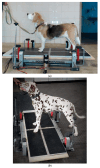Balance Assessment on a Modified Posturomed Platform in Healthy Dogs
- PMID: 39453089
- PMCID: PMC11512307
- DOI: 10.3390/vetsci11100498
Balance Assessment on a Modified Posturomed Platform in Healthy Dogs
Abstract
Reliable, standardized balance tests for dogs are not available yet. The purpose of this study was to investigate the reliability of static and dynamic posturography in healthy dogs. Healthy dogs (n = 20) were positioned with four paws longitudinally and with the forepaws only transversely on a modified pressure-sensitive balance platform (Posturomed-FDM-JS, Zebris, Isny, Germany). Three static and dynamic posturographic trials were recorded (recording duration: 20 s) and repeated after 7-14 days. Center of pressure (COP) parameters COP-path-length (PL; mm), 95% COP-confidence-ellipse-area (CEA; mm2), and COP-average-velocity (AV; mm/s) were calculated for the first steady-state 5 s intervals of each trial. The reliability of COP parameters was assessed with robust linear mixed effects models with nested random effects of patient and trial. The training effect was analyzed using Cohen's d. For static posturography, PL, CEA, and AV did not differ significantly between time points; CEA had the highest reliability (p = 0.92). For dynamic posturography, AV and PL differed significantly between time points (AV: p ≤ 0.043; PL: p ≤ 0.045). Slight training effects were observed for transverse positioning (Cohen's d: PL 0.65; AV 0.267) and moderate training effects for longitudinal positioning (Cohen's d: PL: 0.772; AV: 0.783). This study showed that static posturography on a modified Posturomed-balance platform was reliable in healthy dogs but indicated training effects during dynamic posturography.
Keywords: Posturomed; balance platform; canine; center of pressure; posturography.
Conflict of interest statement
The authors declare that the research was conducted in the absence of any commercial or financial relationships that could be construed as a potential conflict of interest.
Figures




Similar articles
-
Erratum.Mult Scler. 2016 Oct;22(12):NP9-NP11. doi: 10.1177/1352458515585718. Epub 2015 Jun 3. Mult Scler. 2016. PMID: 26041800
-
Postural stability measures in healthy miniature Dachshunds obtained using a pressure mat and a force platform: a validity and reliability study.BMC Vet Res. 2023 Jun 26;19(1):79. doi: 10.1186/s12917-023-03633-0. BMC Vet Res. 2023. PMID: 37365660 Free PMC article.
-
Static posturography across the EDSS scale in people with multiple sclerosis: a cross sectional study.BMC Neurol. 2016 May 20;16:70. doi: 10.1186/s12883-016-0603-6. BMC Neurol. 2016. PMID: 27206921 Free PMC article.
-
Influence of footwear on postural sway: A systematic review and meta-analysis on barefoot and shod bipedal static posturography in patients and healthy subjects.Gait Posture. 2022 Feb;92:302-314. doi: 10.1016/j.gaitpost.2021.11.022. Epub 2021 Nov 26. Gait Posture. 2022. PMID: 34902659
-
Does postural stability differ between adolescents with idiopathic scoliosis and typically developed? A systematic literature review and meta-analysis.Scoliosis Spinal Disord. 2018 Sep 3;13:19. doi: 10.1186/s13013-018-0163-1. eCollection 2018. Scoliosis Spinal Disord. 2018. PMID: 30186976 Free PMC article. Review.
Cited by
-
Improving postural stability through proprioceptive training in dogs.Front Vet Sci. 2025 Jul 23;12:1645875. doi: 10.3389/fvets.2025.1645875. eCollection 2025. Front Vet Sci. 2025. PMID: 40771949 Free PMC article.
-
Impact of Aging and Visual Input on Postural Stability in Dogs: Insights from Center-of-Pressure Analysis.Sensors (Basel). 2025 Feb 20;25(5):1300. doi: 10.3390/s25051300. Sensors (Basel). 2025. PMID: 40096034 Free PMC article.
-
Evaluation of Change in Center of Pressure During Perturbation of Balance Including Blindfolding in Healthy Dogs.Animals (Basel). 2025 Jun 18;15(12):1790. doi: 10.3390/ani15121790. Animals (Basel). 2025. PMID: 40564343 Free PMC article.
References
-
- Horak F.B. Clinical assessment of balance disorders. Gait Posture. 1997;6:76–84. doi: 10.1016/S0966-6362(97)00018-0. - DOI
LinkOut - more resources
Full Text Sources

